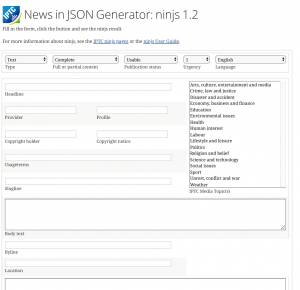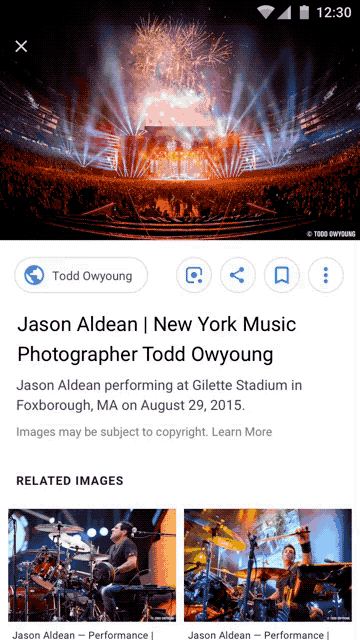Categories
Archives
Following many change requests submitted by news organisations all over the world, the IPTC News in JSON Working Group is happy to announce the 1.2 version of its standard ninjs.

The JSON Schema of the new version can be accessed at https://www.iptc.org/std/ninjs/.
We also created a ninjs User Guide that will enable new and existing users to understand how to put ninjs to use at their organisation.
Version 1.2 is backwards-compatible with version 1.0 and 1.1 and makes no breaking changes.
It includes the following new properties and structures:
- The
firstcreatedproperty goes along with theversioncreatedproperty to specify the date/time when the first version of a news item was published. - The
charcountandwordcountproperties allow the publisher to specify the total character count and word count of a news item (excluding figure captions and metadata). - The
slugline, property allows the publisher to specify a “slug”, a human-readable identifier for the item. (note that no conditions are placed on the usage of this property, usage is up to each publisher). - The
ednote, property allows publishers to specify instructions to editors. - The
infosourcestructure can specify one or many information sources for the news item. It is a metadata structure that can handle literal strings or values from a controlled vocabulary. - The
titleproperty handles “A short natural-language name for the item.”
Also the following sub-properties were added:
- The value
componentwas added to the allowed values fortypeto specify parts of a larger news item. - The description of the
renditionsproperty was changed to allow for any type of rendition, not just images, and new sub-propertiesdurationandformatwere added to enable audio and video renditions (for example, an audio version of a text story).
We have also included a test and validation suite so new versions of the JSON Schema can automatically be checked for compliance and backwards compatibility.
ninjs 1.2 is now included in the SchemaStore.org JSON Schema repository, to aid with editing and validation of ninjs 1.2 files in a range of popular code editors such as Visual Studio Code and Visual Studio 2013+, IntelliJ IDEA, PyCharm and PHPStorm.
For more information, please see:
- The ninjs GitHub repository
- ninjs example documents
- The ninjs User Guide
- The ninjs 1.2 JSON Schema specification
- A new interactive tool for creating example ninjs documents – the ninjs Generator
If you have any questions or comments, please contact the News in JSON Working Group via the public ninjs discussion group, or contact IPTC via the Contact Us form.
At the IPTC Meeting in Ljubljana Slovenia in Autumn 2019, we welcomed several new faces to IPTC working groups, the Board and voted in a new Chair!
With so many changes happening at the same time, we thought it would be good to introduce the new faces here so members and others can get to know them all better. (All IPTC working group leads, committee leads and directors can be found on the Work Structure and About IPTC pages.)
Video Metadata Working Group lead: Pam Fisher
 Pam Fisher is with IPTC as an Individual Member, and we are very happy to have her lead the Video Metadata Working Group, looking at further development and promotion of Video Metadata Hub and video technology in general.
Pam Fisher is with IPTC as an Individual Member, and we are very happy to have her lead the Video Metadata Working Group, looking at further development and promotion of Video Metadata Hub and video technology in general.
Pam has a long history with media and video technology, working with organisations such as BAFTA, Moving Image Research and Communication Arts.
News in JSON Working Group lead: Johan Lindgren
 Johan has led the Sports Content Working Group since 2016 but with the current resurgence of interest in JSON news formats, decided to move to lead the News in JSON Working Group.
Johan has led the Sports Content Working Group since 2016 but with the current resurgence of interest in JSON news formats, decided to move to lead the News in JSON Working Group.
Representing TT Nyhetsbyrån, Sweden’s national news agency, Johan has been active with IPTC for over 20 years, a regular meeting attendee and has been on the IPTC Board since 2016.
Sports Content Working Group lead: Paul Kelly
With Johan taking the reins of the News in JSON group, Paul is stepping (back) up to lead the Sports Content working group. Paul is also a long-time IPTC member, having been lead of the Sports Content working group from 2005 through to 2016 while he represented XML Team Solutions. Now an independent consultant, Paul has retained his ties with IPTC as an Individual Member and we are very happy to see him leading the Sports Content working group once more.
Chair of the IPTC PR Committee: Linda Burman
Linda has been an Individual Member since 2015, and has actively participated in several working groups including the Photo Metadata and Video Metadata Working Groups. We look forward to reviving the IPTC Public Relations Committee under Linda, looking at how to spread the word about the benefits of IPTC to the media industry and beyond.
New Board member: Jennifer Parrucci
 Jennifer has been an IPTC delegate for the New York Times since 2015, and lead of the News Codes Working Group since 2016. Jennifer has done a great job in leading the News Codes Working Group to maintain and develop the News Codes taxonomies, particularly the Media Topics subject vocabulary. We are looking forward to Jennifer’s contributions to the future of IPTC as part of the Board.
Jennifer has been an IPTC delegate for the New York Times since 2015, and lead of the News Codes Working Group since 2016. Jennifer has done a great job in leading the News Codes Working Group to maintain and develop the News Codes taxonomies, particularly the Media Topics subject vocabulary. We are looking forward to Jennifer’s contributions to the future of IPTC as part of the Board.
New Board member: Paul Harman
 Paul Harman has been an IPTC member for over 20 years, first with Press Association and now with Bloomberg LP. Paul worked on NewsML 1, NewsML-G2 and News in JSON (ninjs) while he was an architect with Press Association and carried it on at Bloomberg, his employer since 2014.
Paul Harman has been an IPTC member for over 20 years, first with Press Association and now with Bloomberg LP. Paul worked on NewsML 1, NewsML-G2 and News in JSON (ninjs) while he was an architect with Press Association and carried it on at Bloomberg, his employer since 2014.
Paul is an active member of the News Architecture, News in JSON and News Codes working groups, and we’re very happy to welcome him to the IPTC Board of Directors.
New Chair: Robert Schmidt-Nia
 Robert has been with IPTC since 2007 representing dpa, the German national news agency, where he has been Managing Director of subsidiary dpa mediatechnology since 2013.
Robert has been with IPTC since 2007 representing dpa, the German national news agency, where he has been Managing Director of subsidiary dpa mediatechnology since 2013.
Robert joined the board of IPTC in 2013 and has been a very active participant, so we were very happy to see him voted by the membership to become Chair of the IPTC Board of Directors.
Welcome to everyone and thanks for sharing your time, knowledge and expertise. Your fellow members appreciate it!

Rights-related photo metadata can now be accessed directly in Google Image Search results, thanks to a joint effort by IPTC, Google and CEPIC, the Council of European Professional Informatics Societies.
Google, the IPTC and CEPIC worked together closely to determine the best way to incorporate metadata in Google search results of images to identify an image’s author and rights holder.
When users see an image in a Google search result, they can click the “image credits” link to see the image’s creator and credit information, read from IPTC embedded metadata. Over the coming weeks, copyright notice metadata will also be added.
“Embedded IPTC photo metadata has an essential role for photos posted on a website,” said Michael Steidl, lead of IPTC’s Photo Metadata and Video Metadata Working Groups. “These fields easily show people searching for images who its creator and copyright owner is. We encourage all parties who post images on the web to fill in these IPTC fields.”
Photo metadata is vital to guarding images’ licensing and copyright information online, and essential for managing digital assets.
The IPTC Photo Metadata Standard is the most widely used specification for describing photos, due to its universal acceptance among news outlets, photographers and photo agencies, libraries, museums and other related organisations. Most major photo software vendors support IPTC’s Photo Metadata Standard.
In a recent blog post, Google Image’s product manager Ashutosh Agarwal said this change will help promote “a healthy visual content ecosystem.”
Brendan Quinn, Managing Director of IPTC, said “we are looking forward to continuing our work with Google on IPTC Photo Metadata and other areas. We have a ton of ideas on how we can work together and are looking forward to using our standards to make the web more searchable and more accountable.”
IPTC has prepared a Quick Guide to IPTC Photo Metadata and Google Image Search to help users, developers and site administrators understand what they need to do to ensure that their metadata is shown in Google Image Search results.
For more detailed help with questions and implementation of IPTC’s Photo Metadata standard, see our IPTC Metadata User Guide.
Publishers, broadcasters, news and photo agencies and tool vendors are encouraged to join IPTC to work with us and Google on future projects. See the Participate pages for information on joining and working with IPTC.
“For years, the professional photography community has relied on IPTC metadata as the cornerstone of copyright protection,” said Andrew Fingerman, CEO of PhotoShelter, a provider of digital asset management tools for photographers and brands. “As assets are change hands, pass through organisations, and are published with greater frequency, IPTC metadata provides the basis for identifying the creator and rights owner. This major step by Google and IPTC will help everyone discover, identify, and trace copyright. We applaud this collaboration!”
For more information, contact us via this web site or email Managing Director Brendan Quinn on mdirector@iptc.org.
For more information:
IPTC Photo Metadata Standard – Guidelines and Support
Join the public IPTC Photo Metadata groups.io Group
Join IPTC: Membership Information
Twitter: @IPTC
LinkedIn: IPTC
Google Blog: Images Rights Metadata In Google Images
The International Press Telecommunications Council is happy to announce that RightsML, IPTC’s Rights Expression Language for the media industry, has been updated to version 2.0.
RightsML allows publishers and media owners to express rights permissions and obligations based on geographic, time-based, and monetary restrictions.
This version contains major updates: it is now based on W3C’s Open Digital Rights Language (ODRL) version 2.2 which became a W3C recommendation in February 2018.
ODRL allows content providers to “express permission, prohibition, and obligation statements to be associated to content.” RightsML extends on that base to provide standard expressions for geographic and time-based constraints, on a requirement to pay fixed amounts of money for use of the content,
An example RightsML model which expresses that EPA (Example Press Agency) grants its partners geographic rights to distribute a content item in Germany is as follows:
Policy: type: "http://www.w3.org/ns/odrl/2/Set" uid: "http://example.com/RightsML/policy/idGeog1" profile: "https://iptc.org/std/RightsML/odrl-profile/" permission: - target: "urn:newsml:example.com:20120101:180106-999-000013" assigner: "http://example.com/cv/party/epa" assignee: type: "http://www.w3.org/ns/odrl/2/PartyCollection" uid: "http://example.com/cv/partygroup/epapartners" action: "http://www.w3.org/ns/odrl/2/distribute" constraint: - leftOperand: "http://www.w3.org/ns/odrl/2/spatial" operator: "http://www.w3.org/ns/odrl/2/eq" rightOperand: "http://cvx.iptc.org/iso3166-1a3/DEU"
This content model can also be expressed in XML or JSON. See the RightsML Simple geographic Example for more information.
More examples are on the RightsML 2.0 Examples page on the IPTC developer site.
IPTC has also created tools to help implementors understand and implement RightsML 2.0, including a generic guideline flow for evaluating ODRL documents and a RightsML policy builder tool.
For more details and help on implementing RightsML within your organisation, please join the IPTC RightsML mailing list. Membership of the group is open to the public. For discussion on developing further versions of the standard, please use the IPTC RightsML-dev list, open to all IPTC members.
As announced in late April, Brendan Quinn is succeeding Michael Steidl in the position of Managing Director of IPTC in June 2018.
This change is happening right now: Brendan has taken over the responsibilities and actions of the Managing Director and Michael is available for giving advice to Brendan until the end of June.
From now on Brendan should be contacted as Managing Director. He uses the same email address that Michael used before: mdirector@iptc.org.
Note from Brendan
I’m really looking forward to working with all IPTC’s members and friends, and hope that I can make a real difference to the future of the news and media industry through my work with IPTC.
I aim to speak with as many of you as possible over the next weeks and months to find out what you as members like and don’t like about what IPTC is doing, but in the meantime, please feel free to email me via mdirector@iptc.org or find me on the members-only Slack group, and I would be happy to say hello and to hear your thoughts.
Michael and I sat down to hand over the role in early June so I now have a sense of the task before me, and I hope that I can follow up on his work but also bring a fresh energy to the organisation.
I would especially like to thank Michael for all his efforts over the last 15 years in making IPTC what it is today.
Best regards, and see you in Toronto in October if not before!
Brendan.
Note from Michael
It was a great experience to help Brendan diving into the IPTC universe with all its members and workstreams plus many contacts in the media industry. I wish you, Brendan, all the best for a great future at this organisation.
Dear all who showed interest in IPTC, it was a pleasure getting in touch with you and I hope I was able to respond in a way helping you to solve problems.
I was invited to continue as Lead of the Photo Metadata and Video Metadata Working Groups and I’m happy to take on responsibility for these workstreams. If you want to contact me from now on please use my own email address mwsteidl@newsit.biz
Best,
Michael
“Chasing the SmartPhoto” is the theme of the IPTC Photo Metadata Conference 2018. In the day-long conference, session speakers will examine the image business in a changing environment as new technologies, new devices and Artificial Intelligence will be game changers in the coming years. The Conference will be held in Berlin (Germany) on 31 May 2018. More details and how to register can be found at www.phmdc.org.
In the afternoon session titled “SmartPhotos and Smart Search Engines”, speakers from Google and Qwant will show how their search engines process photos found on the web and how they present search results. This session will include a discussion with conference participants about how photo businesses may critically perceive presentation of copyright protected photos.
”Protecting images Against Infringements” is the topic of another conference session. Publishing a photo on the Web opens up the possibility of anyone downloading and republishing it, without permission or paying for a license. Speakers from photo businesses and service providers will show how to implement copyright protection and how to track downloaded and reused photos using blockchain and other technologies.
The Photo Metadata Conference is organised by the International Press Telecommunications Council (IPTC, iptc.org), the body behind the industry standard for administrative, descriptive, and copyright information about images. It brings together photographers, photo editors, managers of metadata and system vendors to discuss how technical means can help improving the use of images. The Conference is held in conjunction with the annual CEPIC Congress (www.cepic.org).
The International Press Telecommunications Council (IPTC) has named Brendan Quinn as its new managing director.

Quinn joins the IPTC with two decades of experience in managing technology for media companies. In June 2018, he will succeed Michael Steidl, who will retire this summer after 15 years with the organisation. IPTC made the announcement today at their Spring Meeting in Athens.
Quinn brings to the IPTC a vast well of real-life experience in media industry technology, including leading the team that crafted the Associated Press’ APVideoHub.com video syndication platform, implementing content management systems at Fairfax Media in Australia, and handling an array of architecture and R&D roles over nine years with the BBC.
“I’m very much looking forward to my new role as MD for IPTC,” Quinn said. “I have huge respect for the organisation, in fact one of my first open source projects as a developer was writing a Perl module for NewsML v1 back in 2001 while I was a developer in Australia. I’m very proud to now be able to take the lead on defining the role of the IPTC in the challenging environment now faced by the media industry.”
Stuart Myles, Chairman of the Board of IPTC and Director of Information Management at the Associated Press, said he was “thrilled” to welcome Quinn to the organisation.
“He brings with him a wealth of news technology experience, with organisations from around the world and of all sizes. He has a unique combination of strategic insight into the challenges faced by the news industry and the technical know-how to help guide our work in technical standards and beyond.”
IPTC develops technical standards that address challenges in the news and photo industries, and other related fields. Recent IPTC initiatives are the Video Metadata Hub for mapping metadata across multiple existing standards; a major revision of RightsML for expressing machine readable licenses, now aligned with the new W3C standard ODRL; and a comprehensive update of SportsML for covering more efficiently a wide range of sports results and statistics. The Media Topics taxonomy for categorizing news now provides descriptions in four major languages.
Quinn says he looks forward to meeting IPTC members and learning as much as he can about the organization’s standards and outreach work.
“From iconic standards such as IPTC Photo Metadata and NewsML-G2 to emerging standards work like the Video Metadata Hub,” he said, “the IPTC aims to stay relevant in a changing media climate.”
About IPTC:
The IPTC, based in London, brings together the world’s leading news agencies, publishers, and industry vendors. It develops and promotes efficient technical standards to improve the management and exchange of information between content providers, intermediaries, and consumers. The standards enable easy, cost-effective, and rapid innovation and include the Photo Metadata and the Video Metadata Hub standards, the news exchange formats NewsML-G2, SportsML-G2 and NITF, rNews for marking up online news, the rights expression language RightsML, and NewsCodes taxonomies for categorizing news.
IPTC: www.iptc.org
Twitter: @IPTC
Brendan Quinn: @brendanquinn
Stuart Myles: @smyles
The comprehensive NewsML-G2 Guidelines are available now in an updated version and anybody can read them on the web: https://www.iptc.org/std/NewsML-G2/guidelines/
What has been modified:
- The changes of the NewsML-G2 version 2.24 and 2.25 are covered, see https://www.iptc.org/std/NewsML-G2/guidelines/#whats-new-in-newsml-g2-2.5-including-version-2.24
- Some details have been improved, we try to make the guidelines as unambiguous as possible.
- The Quick Start Guides for text, photo/graphics, video and packages have been merged into the web document.
How to use the new Guidelines:
- Quick Start with NewsML-G2 Basics: https://www.iptc.org/std/NewsML-G2/guidelines/#quick-start-guide-to-newsml-g2-basics
- Quick Start with text news: https://www.iptc.org/std/NewsML-G2/guidelines/#quick-start-text
- Quick Start with photo/graphics: https://www.iptc.org/std/NewsML-G2/guidelines/#quick-start-pictures-and-graphics
- Quick Start with video: https://www.iptc.org/std/NewsML-G2/guidelines/#quick-start-video
- Quick Start with packages: https://www.iptc.org/std/NewsML-G2/guidelines/#quick-start-packages
- The Guidelines start at https://www.iptc.org/std/NewsML-G2/guidelines – a full table of content is made available in a sidebar or in the top region.
- Printing the Guidelines is supported: use the Print function of your browser and you should get a very print-friendly rendition of the document. Be aware: about 300 pages.
We welcome feedback on the format and the content of the Guidelines. Use the Contact Us form.
Our current Managing Director Michael Steidl is retiring in the summer of 2018 after 15 years of dedicated service to the IPTC. The IPTC is now seeking applicants to be the next Managing Director of our organization. Feel free to contact Michael (office@iptc.org) or our Chair, Stuart Myles, (chair@iptc.org) if you have any questions.
Job Opportunity: Managing Director of IPTC
For more information about the position, read the full Managing Director profile.
The IPTC is seeking applications for the next Managing Director of our organization. We are the global standards body of the news media and provide the technical foundation for the news ecosystem. Our mission is to simplify the distribution of information. We develop and promote efficient technical standards to improve the management and exchange of information between content providers, intermediaries and consumers.
The Managing Director, working with the Board and Membership, seeks to broaden adoption of IPTC standards, to maximize information sharing between members and to collaborate with partners across the news and media industry. The ideal applicant will have a strong record of working with news technology, presenting a positive image of an organization and administering a membership or non profit organization.
Learn more about IPTC and read the full Managing Director profile.
Applicants should email a letter of interest, curriculum vitae and contact information for three references to office@iptc.org. We will start considering applications on 1 December 2017.
A ODRL (Open Rights Digital Language) Candidate Recommendation was released by W3C’s Permissions & Obligations Expressions (POE) Working Group on 26 September: ODRL has been updated to a generic information model that can be customized by any industry or business sector. IPTC is looking for members and experts with experience in defining licensing information in a machine-readable way to help adapt IPTC’s RightsML standard according to the new ODRL Recommendation, which will specifically address the needs of the news industry.
IPTC’s RightsML – https://iptc.org/standards/rightsml/ – is a standard providing a data model for marking up rights expressions about content of all relevant media types in a machine-readable way. The standard was introduced in 2012 and from the start it was built on ODRL – Open Digital Rights Language – a rights expression framework defined outside IPTC. At that time, a W3C Community Group was backing ODRL.
In early 2016 W3C established a formal Permissions & Obligations Expressions (POE) Working Group – https://www.w3.org/2016/poe/charter – to make a W3C Recommendation from the Community Group specifications, and on 26 September a Candidate Recommendation was released. The work on that W3C Recommendation will be closed by the end of 2017, and IPTC will take action to align a next RightsML version with the Recommendation.
IPTC Action: Update RightsML by Synchronising It With the New W3C Recommendation as ODRL RightsML Profile
The transfer of ODRL from a Community Group to a Recommendation approved by the W3C Consortium was not only a copy and paste action. The basic design has not been changed but the status of many actions, constraints or party functions has been changed from “normative” to “non-normative.” The reason was to make the ODRL Recommendation a generic information model which can be easily adapted to the different needs of various business sectors. This has been demonstrated by the range of participants of the W3C Working Group covering needs and interests from media companies and their trade associations, financial data providers, and universities.
The solution for that is called ODRL Profile: it defines all the actions, kinds of constraints, types of involved parties and more which are typical to a business sector and these definitions are add-ons to the basic Information Model of the Recommendation. This also slims down the specifications: businesses behind media assets don’t have to take care of the requirements regarding e.g. scientific papers.
IPTC has taken the role of defining the RightsML Profile of ODRL covering the needs of the news industry. Writing down the definitions fitting into the context of ODRL will not be that hard. Michael Steidl and Stuart Myles of the IPTC are invited experts of the ODRL/POE Working Group and have been active in its development from the start.
The big challenge is to determine which business needs of the news industry should be covered by the actions, constraints or parties defined by the RightsML Profile. To achieve that we need people from IPTC members and experts from other companies who have any experience in defining licensing information in a machine-readable way. Regular conference calls will take place from October 2017 to early 2018 to select and define what should be included to update RightsML Profile.
ODRL: From Candidate Recommendation to the Final Recommendation
On 26 September 2017, W3C published the Candidate Recommendation of ODRL. Links to the relevant W3C documents and other relevant resources are provided in the Details section below.
This opens a test phase until mid-November; in this period the Information Model and Vocabulary documents should be reviewed and comments may be posted. Further, W3C procedures specify that the Information Model and Vocabulary should be implemented into software at least by two parties and be tested against a list of criteria. Any party interested in ODRL and all IPTC members are invited to take this action. For more information contact Michael Steidl (mdirector@iptc.org).
Details for Creating the RightsML ODRL Profile:
- POE Working Group Charter: https://www.w3.org/2016/poe/charter
- POE Working Group home page: https://www.w3.org/2016/poe/wiki/Main_Page
- ODRL Information Model – Candidate Recommendation: https://www.w3.org/TR/2017/CR-odrl-model-20170926/
- ODRL Vocabulary – Candidate Recommendation: https://www.w3.org/TR/2017/CR-odrl-vocab-20170926/
- RightsML Profile outline: http://w3c.github.io/poe/rightsml/ (currently only the section heads are shown)
- The RightsML landing page of the IPTC website: https://iptc.org/standards/rightsml/
- The current RightsML on the IPTC Developer Site: http://dev.iptc.org/RightsML
- The current and small RightsML specification document: http://www.iptc.org/std/RightsML/1.1/RightsML_1.1EP2-spec_1.pdf
- IPTC contact: Michael Steidl – mdirector@iptc.org
Categories
Archives
- December 2025
- November 2025
- October 2025
- September 2025
- August 2025
- July 2025
- June 2025
- May 2025
- April 2025
- March 2025
- February 2025
- January 2025
- December 2024
- November 2024
- October 2024
- September 2024
- August 2024
- July 2024
- June 2024
- May 2024
- April 2024
- March 2024
- February 2024
- December 2023
- November 2023
- October 2023
- September 2023
- August 2023
- July 2023
- June 2023
- May 2023
- March 2023
- February 2023
- January 2023
- December 2022
- November 2022
- October 2022
- September 2022
- August 2022
- July 2022
- June 2022
- May 2022
- April 2022
- March 2022
- February 2022
- January 2022
- December 2021
- November 2021
- October 2021
- September 2021
- August 2021
- July 2021
- June 2021
- May 2021
- April 2021
- February 2021
- December 2020
- November 2020
- October 2020
- September 2020
- August 2020
- July 2020
- June 2020
- May 2020
- April 2020
- March 2020
- February 2020
- December 2019
- November 2019
- October 2019
- September 2019
- July 2019
- June 2019
- May 2019
- April 2019
- February 2019
- November 2018
- October 2018
- September 2018
- August 2018
- July 2018
- June 2018
- May 2018
- April 2018
- March 2018
- January 2018
- November 2017
- October 2017
- September 2017
- August 2017
- June 2017
- May 2017
- April 2017
- December 2016
- November 2016
- October 2016
- September 2016
- August 2016
- July 2016
- June 2016
- May 2016
- April 2016
- February 2016
- January 2016
- December 2015
- November 2015
- October 2015
- September 2015
- June 2015
- April 2015
- March 2015
- February 2015
- November 2014